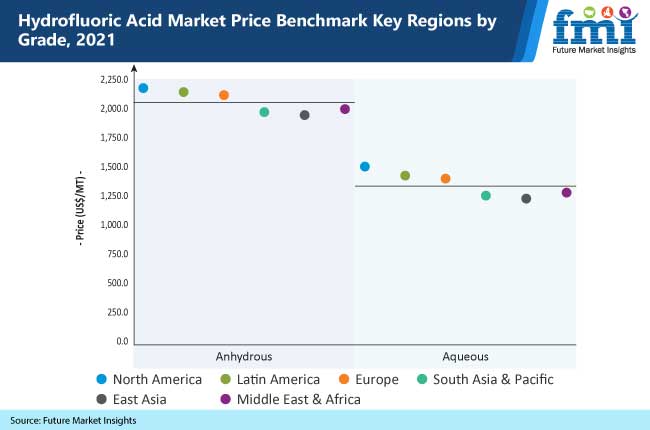Increasing demand for high-octane gasoline, fluorine compounds, and electronics is expected to aid the growing demand for hydrofluoric acid. According to a new study by Future Market Insights (FMI), the market for hydrofluoric acid is set to rise sluggishly with a CAGR of less than 3% through the end of the projection period in 2031. The global requirement for hydrofluoric acids has grown steadily owing to wide scope of applications for refrigerant compounds in multiple sectors. Strict government regulations associated with the environmental impacts of fluorocarbons will influence long-term demand. In metal sector operations, hydrofluoric acid also finds roles in the processing and production of aluminum products for automotive and packaging sectors.
Request FREE PDF Brochure This Report: https://www.futuremarketinsights.com/reports/brochure/rep-gb-6176
Hydrofluoric acid is also used in the chemical processing sector in multiple roles including as etching agents, cleaning agents, and for the production of fluorides such as sodium fluoride, cryolite, and aluminum trifluoride, in addition to fluorocarbons, fluoropolymers, freons, and more. Hydrofluoric acid is also gaining attention as a precursor to niche drugs, a key factor which indicates regular demand from the global pharmaceutical industry.
The growing demand for hydrofluoric acids, particularly from emerging economies will influence the direction of the market. On the other hand, the high concentration of fluorspar in China unbalances production capabilities. In addition, health and environmental concerns are also issues holding back growth. With further restraints on end user industries, during the covid-19 pandemic, demand is likely to recover gradually through 2021.
Key Takeaways of Hydrofluoric Acid Market Study
- Hydrofluoric acid sales to increase at 2.9% CAGR through the assessment period.
- The dominant fluorochemical applications of hydrofluoric acid, are likely to decline in the near future owing to stringent regulations associated with climate change.
- Continuing demand for fluorochemicals the metal industry allows Germany to register a relatively higher growth rate.
- United States market is projected to face major challenges owing to strict environment protection regulations.
- China will remain a dominant market, owing to easy availability and restrictions on imports associated with key raw materials.
“The consumption of hydrofluoric acid in the production of fluorinated derivatives is growing rapidly. Other niche applications including pharmaceuticals production, glass etching and cleaning, metal pickling, uranium fuel production, and oil refining will continue to support sales, even as manufacturers eke out new strategies to sustain growth through ever-restricting environmental regulations,” says an FMI analyst.
Request a Complete TOC of this Report with figures: https://www.futuremarketinsights.com/toc/rep-gb-6176
Fluorspar Constraints Influence Market Developments
According to FMI, the unbalanced state of global fluorspar supplies, has pushed hydrofluoric acid manufacturers to focus on the development of alternative production avenues to reduced the gap in raw material supplies.
The use of fluorosilicic acid has been gaining traction in the industry. The material is produced through reactions between sulfuric acid and phosphate rock with silicates. It is being viewed as a commercially feasible alternative to fluorspar supplies.
Currently, the use of fluorosilicic acid for the production of hydrofluoric acid is still in a nascent stage. However, an increasing number of manufacturers are expected to adopt the technology over the coming decade. The major advantage of this method is the significant reduction in production costs, resulting in a substantial rise in profit margins for the foreseeable future.
Hydrofluoric Acid Market by category
Grade
- Anhydrous
- Aqueous
Application
- Fluorochemicals
- Steel Pickling and Metal Treatment
- Petroleum Catalyst
- Glass Etching
- Electronics & Semiconductor
- Others
Region
- North America
- Latin America
- Europe
- East Asia
- South Asia & Pacific
- Middle East & Africa
Who is Winning?
The global hydrofluoric acid market can be considered as moderately consolidated, with a few leading players accounting for a major share of the overall hydrofluoric acid production. Manufacturers are increasingly focused on investments into research and development aimed towards product development with a focus on environment protection.
Key market participants including
- Gulf Fluor,
- Laxness AG,
- Solvay SA,
- Honeywell International,
- Buss ChemTech AG,
- Sinochem International Corp.,
- Tanfac Industries Ltd.,
- Fubao Group,
- Navin Fluorine International Limited,
- Merck KGaA,
- SRF Limited,
- Gujarat Fluorochemicals Ltd.,
- Stella Chemifa Corporation,
- Morita Chemical Industries Co. Ltd., and
- Soulbrain Co., Ltd.
amongst others are also focusing on consolidating their presence in the global market by diversifying supplies and distribution channels, dealing with the fallout of the covid-19 pandemic.
Want to Know More?
Future Market Insights has published a market research report on the hydrofluoric acid market that contains global industry analysis for 2016–2020 and opportunity assessment for 2021–2031. The report provides insightful analysis of the hydrofluoric acid market through three different segments- grade, application, and region. The hydrofluoric acid market report further provides demand trends of different types across industry verticals, a comprehensive list of service providers in the market along with a detailed overview of the parent market.
Ask us your Any Queries About this Report: https://www.futuremarketinsights.com/askus/rep-gb-6176
About Chemicals & Materials division of FMI
The Chemicals & Materials division at FMI offers distinct and pin-point analysis about the chemicals & materials industry. Coverage of the chemicals and materials market extends from commodity, bulk, specialty and petrochemicals to advanced materials, composites, and nanotechnology. The team also puts special emphasis on ‘green alternatives’, recycling and renewable technology developments, and supply-demand trade assessment. Our research studies are widely referred by chemical manufacturers, research institutions, channel partners, and government bodies for developing – ‘The Way Forward’.

